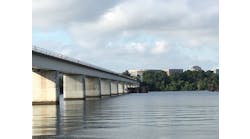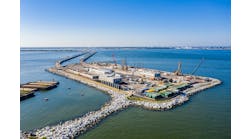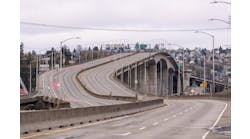Bertha will not be coming in contact with the Alaskan Way Viaduct during demolition.
That’s a good thing, because crews will have no more time to spare when they rip down the 1953 structure piece by piece. Bertha was the tunnel-boring machine used to create the new S.R. 99 tunnel, which will replace the viaduct, and caused almost complete chaos when it shut down for months in 2013. It took four years for the boring machine to break through on the north end of the job, which happened during the first week of April. What will be touching the old viaduct is a team of concrete breakers, as Kiewit Infrastructure West breaks the 1.7-mile elevated roadway one section at a time.
At press time a lot of the details of the design-build demolition contract were unknown. The contract was executed on July 10 and includes demolishing the viaduct, decommissioning and filling in the Battery Street Tunnel, which was built in 1954, and creating new surface streets at the north end of the project. Aurora Avenue, which takes motorists into the Battery Street Tunnel, will be raised and connected to cross streets. Three streets will open as through streets to get people from lower Queen Anne to South Lake Union. Harrison, Thomas and John streets will be constructed and should create a big impact in terms of traffic management.
“It is really great we are at the point where the viaduct demolition is in sight,” Laura Newborn, spokesperson for the Washington State Department of Transportation (WSDOT), told Roads & Bridges. “Mainly because at the end of the day this whole project, and all of the other projects associated with this whole program, was a safety program, because the viaduct is old and is not seismically safe. It will be a relief for a lot of people.”
But before the relief there may be some tension. Final ramps and roads still need to be connected to the tunnel, and WSDOT will have to close S.R. 99 for three weeks in order for crews to get the work done. Over 90,000 vehicles use the route daily.
“We are talking about it now,” said Newborn. “We are making sure people know. We are coordinating with a lot of transit agencies in the area as well as the city. It is a lot to ask, and we know that, but there really is no choice. It is the only way we can get the work done.”
In late July, the project’s prime contractor, Seattle Tunnel Partners, was in the middle of doing extensive testing on the systems inside the tunnel. The testing consisted of three layers. The first layer—pre-functional testing—involved making sure each individual piece of equipment worked. When Roads & Bridges checked in on the project, crews were in the middle of conducting functional testing to make sure all of the systems work. Fire safety, ventilation, lighting and communication systems were all being checked. Then in the final stage—integrating testing—the goal is to make sure all of the systems are communicating with one another.
Newborn said the fire safety system in the new S.R. 99 tunnel is one of the most complex in the world. If linear heat detectors in the tunnel pick up a high level of heat, cameras swing into action to pinpoint the location of the heat source. Video is sent to the tunnel operator and a countdown starts for the sprinkler system to activate. The tunnel operator can speed up the countdown, slow it down or cancel it.
Crews pave a new intersection in the south portal of the S.R. 99 tunnel project.
“It is really a complex set of things that have to happen together,” said Newborn.
Crews were tining the concrete pavement inside the tunnel in late July, and striping was about to take place.
The project also consists of a north portal and a south portal. The north corridor is complete, other than the road connections to the tunnel. The north portal is located just east of the Seattle Center near the intersection of Harrison Street and Sixth Avenue North. At press time work was still going on in the south portal, mainly involving work on ramps to get ready for the tunnel connection.
Back in 2011, Alaskan Way was squeezed in between the Alaskan Way Viaduct’s concrete footings to make room for the tunnel construction. Now that demolition of the viaduct is on the horizon the focus has been on restoring the street to its original location, which was west of the viaduct in the south portal.
In early July, pavement work was in effect on the south end, creating the future Alaskan Way South/South Dearborn Street intersection.
The tunnel was supposed to open in 2016. That plan was vaporized after the tunnel-boring machine froze. Now the aim is to have all work done by the fall, meaning it could be as late as November or December. A lot depends on how the testing goes.
“We are hoping, hoping, hoping that we can get the tunnel open by Thanksgiving, but a lot of that depends on the Seattle Tunnel Partners’ schedule and how the testing proceeds.”
As for Bertha, workers began cutting the 7,982-ton tool into hundreds of 20-ton pieces in April. The sections were trucked away, and they could be used on another project, or they could just be recycled.



